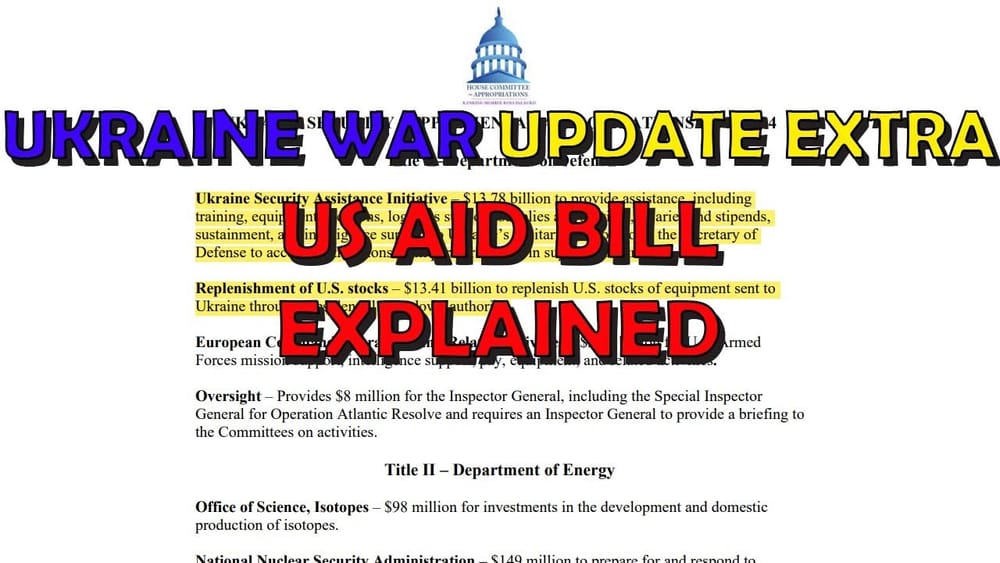Ukraine War Upd. EXTRA: US Aid Bill Explained.
Table of Contents 📖
"The public has been led to believe that Ukraine has been sent $113 billion in hard cash, and American politicians are still making this worse by failing to craft a bill that addresses Ukraine's actual needs."
Hello Team
🎦 00:00-00:13⏩
Jonathan introduces the topic for today's Ukraine War Update EXTRA video: a deep dive into the recently passed US Aid bill.
Return to top⤴️
US Aid Bill Summary
🎦 00:14-01:09⏩
Jonathan provides an overview of the US Aid bill, highlighting the three main components:
- $13.78 billion in US AI (Ukraine Security Assistance Initiative) for procuring defence articles.
- $13.41 billion for replenishing US stocks.
- $7.8 billion in Presidential Drawdown Authority (PDA), enabling the transfer of existing US stock to foreign countries.
Understanding Presidential Drawdown Authority
🎦 01:09-12:08⏩
Before delving into the current aid package, Jonathan analyses a 109-tweet thread by Colby Badwell that clarifies the complexities of the Presidential Drawdown Authority (PDA), drawing upon insights from an April 8th thread concerning the March PDA. Jonathan explains that US military aid to Ukraine flows mainly through two channels:
- Presidential Drawdown Authority (PDA): Facilitates emergency transfers of existing US military stock (weapons, ammunition, equipment) to foreign countries, offering the quickest method of supplying Ukraine.
- Ukraine Security Assistance Initiative (USAI): Enables the DoD to purchase defence articles from manufacturers or allied nations. Commitments under USAI often involve lengthy lead times for production and delivery (e.g., NASAMS batteries ordered for delivery in 2026).
Jonathan clarifies a common misunderstanding: the $100 million cap on PDA applies cumulatively to all foreign recipients, not individually. Key point: The value of transferred defence articles under PDA is determined by their net book value (acquisition cost minus depreciation), not their replacement cost. This means older, depreciated items, though still valuable, have a lower impact on PDA funds. Jonathan explains that PDA transfers don't directly cost the US and can sometimes even save money by avoiding the expense of destroying obsolete equipment. Jonathan discusses a situation where the DoD had exhausted its USAI budget but still had $3.9 billion unspent from PDA. This, he suggests, will likely be carried over to the current aid package.
Return to top⤴️
Replenishing US Military Stocks
🎦 12:08-14:18⏩
Jonathan explains that while there's no legal obligation, the DoD typically aims to replace equipment provided to Ukraine through PDA. This leads to the allocation of $13.4 billion in the current bill for replenishing US stocks. Congress has appropriated $25.9 billion to date for replacing items sent to Ukraine, exceeding the $25.5 billion authorised for PDA.
Return to top⤴️
Discrepancies in PDA and Replacement Funds
🎦 14:18-19:11⏩
A seeming contradiction arises: $3.9 billion remains unspent from previous PDA allocations, while replacement funds appear exhausted, despite a higher total appropriation. Jonathan, again citing Colby, explains that this discrepancy stems from several factors:
- Contract Negotiation Savings: When contracted costs for replacements are lower than initially estimated, the surplus returns to the replacement fund for reallocation.
- Broader Use of Replacement Funds: The $25.9 billion for replacements isn't solely for direct equipment replacement. It also covers:
- Expanding US munitions production.
- Reimbursing costs for services rendered to Ukraine by the DoD and US allies.
- Transportation expenses for delivering defence articles to Ukraine.
- Non-One-to-One Replacement: The DoD doesn't replace items on a strict one-for-one basis. For instance, sending 1 million standard artillery shells doesn't necessitate procuring 1 million identical replacements. Instead, they might opt for a smaller quantity of more advanced Excalibur precision-guided munitions based on strategic needs. This approach challenges the assumption of a dollar-for-dollar replenishment strategy.
Jonathan highlights the US Air Force's approach, as explained by their acquisition chief, which prioritises procuring new equipment based on capability needs rather than merely replicating existing inventory.
Return to top⤴️
Impact of PDA on US Readiness
🎦 19:11-23:08⏩
Jonathan addresses the impact of PDA transfers on US military readiness, acknowledging that sending essential equipment to Ukraine inevitably affects readiness, at least temporarily, as replacements aren't instantaneous. Even with expedited contracting processes, procurement remains a slow process. Jonathan emphasizes that delays are inherent to both USAI and replenishment efforts, citing examples of extended lead times for Bradleys, M795 shells, and PAC-3 MSE Patriot missiles. Some orders placed in 2023 won't see delivery until 2026. Key takeaway: The lack of immediate replacement funds doesn't equate to an immediate readiness crisis, as those funds would be used to acquire equipment with a production timeline extending far into the future.
Return to top⤴️
Dissecting the USAA (Ukraine Bill)
🎦 23:08-36:02⏩
Shifting focus to the specifics of the recently passed $95 billion National Security Supplemental Appropriations Act, which encompasses aid for Ukraine, Israel, Indo-Pacific allies, and the US defence industrial base, Jonathan zeroes in on the Ukraine bill, or USAA. He criticizes the misleading reporting that inaccurately frames the bill as providing $60 billion in direct military aid to Ukraine. Jonathan breaks down the figures:
- Total USAA appropriation: $60.776 billion.
- Security-related accounts: $50.679 billion (83.4%).
- Economic and humanitarian aid: $10.01 billion (16.6%).
- A significant portion of the security-related funding remains within the US, primarily allocated to the Department of Defense.
Jonathan provides further details:
- $6.5 billion is earmarked for US European Command (EUCOM) operations, covering expenses related to troop deployments and operations in response to the Ukraine conflict.
- $13.8 billion is allocated to USAI, supplementing the $18.9 billion previously appropriated. Colby criticizes the USAI program as a "disaster" due to $6.6 billion remaining uncontracted.
- $13.4 billion is designated for the replacement fund, falling short of the Biden administration's initial request for $18 billion. The Senate's decision to cut this allocation, while boosting procurement accounts, raises questions about their motives and transparency.
Jonathan argues that a minimum of $34 billion was needed for replacements to cover the existing shortfall and new PDA allocations. Failing to provide adequate replacement funding could hinder future PDA utilization and negatively impact US readiness.
Return to top⤴️
Breakdown of USAA Allocations
🎦 36:02-39:44⏩
Jonathan examines further aspects of the USAA:
- $13.3 billion for services, primarily to bolster production and procurement of crucial munitions and enhance EUCOM cybersecurity. While indirectly benefiting Ukraine, these funds primarily serve US interests.
- $633 million for research, development, testing, and evaluation (RDT&E) to support EUCOM cybersecurity and other needs.
- $8 million for the DoD Inspector General to oversee aid to Ukraine.
- $2 million for intelligence community support in investigating Russian war crimes.
- $150 million to the Department of Energy for nuclear and radiological response support to Ukraine, plus $98 million for nuclear isotope production.
- $7.9 billion in forgivable loans for economic support to Ukraine.
- $1.6 billion in assistance to Ukraine and other affected countries in the region.
- $400 million for civilian law enforcement security needs, potentially used to procure vehicles for Ukraine's border guard service.
- $1.6 billion in Foreign Military Financing (FMF) loans for Ukraine and other European nations to purchase US equipment. Jonathan views FMF as preferable to USAI, as it grants Ukraine more control over procurement.
Jonathan concludes that only $23.6 billion from the USAA directly supports Ukraine's security, with $15.8 billion (26% of the total) allocated for actual military equipment.
Return to top⤴️
Criticism of USAA and Media Reporting
🎦 39:44-41:04⏩
Jonathan criticizes the Biden administration's handling of aid budgeting, arguing that the inclusion of funds not directly benefiting Ukraine in the USAA creates a misleading perception of the actual support provided. He blames the media for failing to scrutinize the legislation and accurately convey its contents to the public, thereby playing into the hands of Russian disinformation efforts.
Return to top⤴️
Hopes for Effective Aid Utilization and Future Needs
🎦 41:04-41:54⏩
While acknowledging the bill's signing and some positive initial steps, Jonathan expresses concerns about correcting past mistakes and the need for the allocated funds to adequately address Ukraine's needs throughout 2024. He anticipates the potential need for further aid bills, emphasizing the importance of lessons learned and continued support for Ukraine. Jonathan expresses gratitude to Colby Badwell for his analysis of this complex legislation.
Return to top⤴️
Wrap up
🎦 41:54-42:55⏩
Jonathan acknowledges that this video was "dry" due to its focus on the intricacies of the aid package, but emphasizes the importance of understanding the details to avoid misinterpretations. He reiterates that it wasn't a $60 billion military aid package as misreported in the media, emphasizing the need to correct such inaccuracies. Jonathan encourages viewers to challenge misleading narratives and promote a more accurate understanding of the situation.
Return to top⤴️



